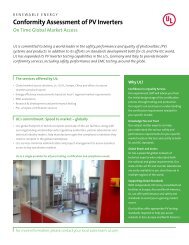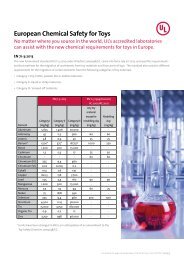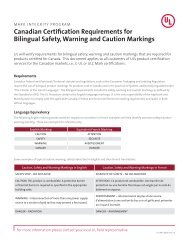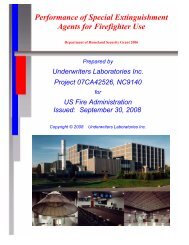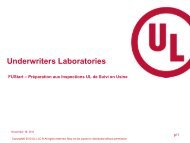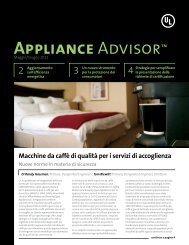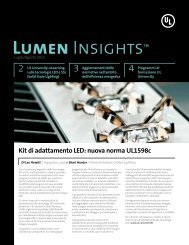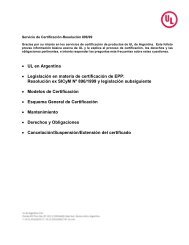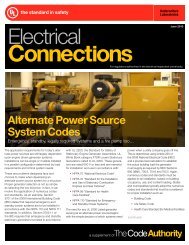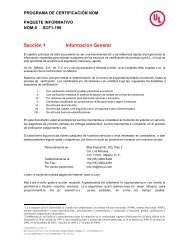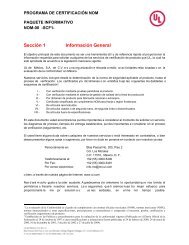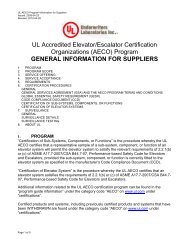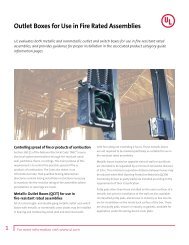Inverters in Photovoltaic Systems - UL.com
Inverters in Photovoltaic Systems - UL.com
Inverters in Photovoltaic Systems - UL.com
You also want an ePaper? Increase the reach of your titles
YUMPU automatically turns print PDFs into web optimized ePapers that Google loves.
2012 • January<br />
<strong>Inverters</strong> <strong>in</strong> <strong>Photovoltaic</strong> <strong>Systems</strong><br />
In general, <strong>in</strong>verters convert the<br />
output of an <strong>in</strong>tended power source<br />
to an appropriate AC voltage and<br />
frequency for direct domestic and<br />
<strong>in</strong>dustrial use. More <strong>com</strong>plex units can<br />
also supply power to the utility grid.<br />
<strong>Inverters</strong> are available <strong>in</strong> numerous<br />
types, sizes and configurations. Code<br />
authorities often have questions<br />
about the <strong>in</strong>stallation of <strong>in</strong>verters<br />
and what is needed to achieve a safe,<br />
code-<strong>com</strong>pliant photovoltaic (PV)<br />
<strong>in</strong>verter <strong>in</strong>stallation. Photo provided courtesy of SMA<br />
Many of these concerns can be resolved<br />
by understand<strong>in</strong>g what is covered<br />
by the <strong>in</strong>verter’s certification, and by<br />
referenc<strong>in</strong>g the <strong>in</strong>stallation <strong>in</strong>structions.<br />
<strong>Inverters</strong> <strong>in</strong>tended to be operated <strong>in</strong><br />
parallel with an electric power system<br />
to supply power to <strong>com</strong>mon loads, or<br />
as an <strong>in</strong>dependent power source, are<br />
<strong>in</strong>vestigated <strong>in</strong> accordance with the<br />
requirements <strong>in</strong> <strong>UL</strong> 1741, the Standard<br />
for Safety for <strong>Inverters</strong>, Converters,<br />
Controllers and Interconnection System<br />
Equipment for use with Distributed Energy<br />
Resources. <strong>Inverters</strong> covered by <strong>UL</strong> 1741<br />
are <strong>in</strong>tended for use <strong>in</strong> stand-alone (not<br />
grid-connected) or utility-<strong>in</strong>teractive<br />
(grid-connected) power systems. <strong>Inverters</strong><br />
covered by these requirements are<br />
<strong>in</strong>tended to be <strong>in</strong>stalled <strong>in</strong> accordance<br />
with the National Electrical Code (NEC).<br />
However, not all <strong>in</strong>verters are <strong>in</strong>tended<br />
to be <strong>in</strong>stalled with PV systems. Other<br />
types of power sources, such as fuel cells,<br />
microturb<strong>in</strong>es and w<strong>in</strong>d turb<strong>in</strong>es, supply<br />
power through <strong>in</strong>verters specifically<br />
identified for the application. Source-type<br />
codes are marked on the <strong>in</strong>verter to<br />
identify the application for which<br />
the <strong>in</strong>verter has been evaluated. PV<br />
system <strong>in</strong>verters are identified with the<br />
source-type code “PV”. The source-type<br />
codes for other <strong>in</strong>verters are “FC” (fuel cell),<br />
“MT” (microturb<strong>in</strong>e), “WT” (w<strong>in</strong>d turb<strong>in</strong>e),<br />
“HT” (hydro turb<strong>in</strong>e), and “B” (battery).<br />
NEC requires listed <strong>in</strong>verters<br />
There are several sections with<strong>in</strong> the NEC<br />
that require the use of listed <strong>in</strong>verters:<br />
• NEC Section 551.32 requires that<br />
<strong>in</strong>verters used <strong>in</strong> recreation vehicles are<br />
to be listed and <strong>in</strong>stalled <strong>in</strong> accordance<br />
with the terms of the list<strong>in</strong>g.<br />
• NEC Section 690.4(D) requires that<br />
<strong>in</strong>verters used with PV systems are to<br />
be identified and listed for PV systems.<br />
• NEC Section 690.35(G) requires that<br />
<strong>in</strong>verters used <strong>in</strong> PV systems with an<br />
ungrounded PV source and output<br />
circuits are to be specifically listed for<br />
use with an ungrounded PV system.<br />
cont<strong>in</strong>ued on page 2
<strong>Inverters</strong> <strong>in</strong> <strong>Photovoltaic</strong> <strong>Systems</strong> (cont<strong>in</strong>ued)<br />
• NEC Section 694.7(B) requires that <strong>in</strong>verters<br />
used <strong>in</strong> small w<strong>in</strong>d electric systems are to<br />
be identified and listed for w<strong>in</strong>d systems.<br />
• Where <strong>in</strong>verters are <strong>in</strong>stalled with<strong>in</strong><br />
<strong>in</strong>teractive electrical systems, NEC<br />
Sections 690.60 and 694.60 require<br />
them to be listed and identified<br />
for <strong>in</strong>teractive system use.<br />
• NEC Section 705.4 requires utility<strong>in</strong>teractive<br />
<strong>in</strong>verters used as part of<br />
an <strong>in</strong>terconnected electric power<br />
production source to be listed and<br />
identified for <strong>in</strong>terconnection service.<br />
Listed <strong>in</strong>verters<br />
<strong>Inverters</strong> are listed under the Static<br />
<strong>Inverters</strong>, Converters and Accessories<br />
for use <strong>in</strong> Independent Power <strong>Systems</strong><br />
product category (QIKH), which is located<br />
with<strong>in</strong> the <strong>UL</strong> White Book or by access<strong>in</strong>g<br />
the <strong>UL</strong> Onl<strong>in</strong>e Certifications Directory.<br />
This category covers permanently<br />
connected <strong>in</strong>verters and converters for<br />
use <strong>in</strong> electric power systems. <strong>Inverters</strong><br />
are devices that change DC power to AC<br />
power, whereas converters are devices<br />
that accept AC or DC power <strong>in</strong>put and<br />
converts it to another form of AC or DC<br />
power for direct utilization by a load or<br />
accumulation <strong>in</strong> an energy storage system<br />
(batteries, capacitors, etc.). Devices covered<br />
under this category are classed as Utility<br />
Interactive, Stand-alone or Multimode.<br />
Utility Interactive devices operate <strong>in</strong> parallel<br />
with the utility grid. Stand-alone devices<br />
are <strong>in</strong>tended to operate <strong>in</strong>dependent<br />
of the utility grid, whereas Multimode<br />
devices can operate as both or either<br />
Stand-alone or Utility Interactive devices.<br />
<strong>Inverters</strong> may be connected to different<br />
types and <strong>com</strong>b<strong>in</strong>ations of distributed<br />
generation sources, <strong>in</strong>clud<strong>in</strong>g generator<br />
sets, photovoltaic cells, fuel cells, w<strong>in</strong>d<br />
Published by <strong>UL</strong><br />
Manag<strong>in</strong>g Editor: Jeffrey A. Fecteau<br />
T: 1.651.408.8562<br />
E: Jeffrey.Fecteau@ul.<strong>com</strong><br />
W: ul.<strong>com</strong>/tcaec<br />
and microturb<strong>in</strong>es or other sources as<br />
specified <strong>in</strong> the manufacturer’s <strong>in</strong>stallation<br />
<strong>in</strong>structions. <strong>Inverters</strong> <strong>in</strong>tended to<br />
be <strong>in</strong>stalled and operated with an<br />
external transformer are provided with<br />
mark<strong>in</strong>gs and <strong>in</strong>structions to <strong>in</strong>dicate<br />
the type of transformer required.<br />
<strong>Inverters</strong> may also require external<br />
output overcurrent protection, which is<br />
specified with<strong>in</strong> the product mark<strong>in</strong>gs and<br />
<strong>in</strong>stallation <strong>in</strong>structions. These products<br />
require external overcurrent protection to be<br />
sized at 125 percent of the product output<br />
current rat<strong>in</strong>g unless otherwise specified.<br />
They may also require that overcurrent<br />
protection be provided <strong>in</strong> the source<br />
circuits. These protection rat<strong>in</strong>gs are also<br />
specified <strong>in</strong> the <strong>in</strong>stallation <strong>in</strong>structions.<br />
Mark<strong>in</strong>gs and <strong>in</strong>structions<br />
Listed <strong>in</strong>verters are marked with source<br />
types (<strong>Photovoltaic</strong>, W<strong>in</strong>d Turb<strong>in</strong>e etc.),<br />
output types (Utility Interactive, Stand-alone<br />
etc.), utility applications (Anti-island<strong>in</strong>g,<br />
over/under voltage and frequency<br />
fluctuations), isolation (transformer or<br />
transformerless), <strong>in</strong>put and output power<br />
configuration (S<strong>in</strong>gle-phase or Three-phase),<br />
maximum overcurrent protection, enclosure<br />
environmental rat<strong>in</strong>g, maximum ambient<br />
temperature of cont<strong>in</strong>uous operation<br />
at full rated power and maximum<br />
ambient operation temperature.<br />
<strong>UL</strong> Certified <strong>in</strong>verters <strong>in</strong>clude a<br />
<strong>UL</strong> Listed Mark on each product.<br />
If units are shipped <strong>in</strong> multiple sections<br />
and must be field assembled to make a<br />
<strong>com</strong>plete listed product, each enclosure<br />
section is provided with a “Section _____<br />
of _____” mark<strong>in</strong>g. The second blank<br />
<strong>in</strong>dicates the total number of enclosure<br />
sections while the first blank <strong>in</strong>dicates<br />
the respective enclosure section number<br />
bear<strong>in</strong>g the <strong>UL</strong> Mark, such as Section 2 of 4.<br />
[ 2 ]<br />
[ 2012 • January ]<br />
However, for units shipped <strong>in</strong> multiple<br />
sections consist<strong>in</strong>g of a <strong>com</strong>plete end<br />
product and associated optional accessories<br />
the <strong>com</strong>plete end product has a s<strong>in</strong>gle<br />
List<strong>in</strong>g Mark and any accessories are labeled<br />
with one of the product designations,<br />
preceded by the words “Accessory for”.<br />
Sample <strong>UL</strong> Listed Label<br />
Installation <strong>in</strong>structions are required to<br />
be provided with listed <strong>in</strong>verters. These<br />
<strong>in</strong>structions <strong>in</strong>clude important <strong>in</strong>formation<br />
that is required to make sure the products<br />
are <strong>in</strong>stalled <strong>in</strong> accordance with their<br />
list<strong>in</strong>g. Code authorities should require and<br />
review the <strong>in</strong>verter <strong>in</strong>stallation <strong>in</strong>structions<br />
as part of the <strong>in</strong>spection process.<br />
For additional <strong>in</strong>formation on listed<br />
<strong>in</strong>verters, please contact Jeff Fecteau<br />
at Jeffrey.Fecteau@.ul.<strong>com</strong> or at<br />
+1.952.838.5452.<br />
<strong>UL</strong> and the <strong>UL</strong> logo are trademarks of <strong>UL</strong> LLC © 2012. BDi 01/12 12XXXX



